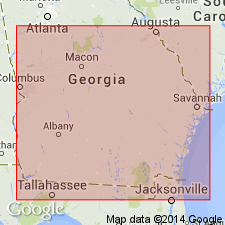
- Usage in publication:
-
- Tybee Phosphorite Member
- Modifications:
-
- Named
- Dominant lithology:
-
- Sand
- Clay
- Dolomite
- AAPG geologic province:
-
- South GA-North FL sedimentary province
Summary:
Tybee Phosphorite Member is here named for Tybee Island in southeast GA. Name is applied to the subsurface, basal phosphoritic beds of the Coosawhatchie Formation of the Hawthorne Group in the coastal area of GA. Eastern limit is unknown, but it occurs on the continental shelf off the coast of GA. Westward, in Chatham Co., the member separates into two thin tongues. Extends southward at least as far as Camden Co. Strata have been mapped previously as part of the Duplin Formation (Furlow, 1969). Unit is here recognized as part of the Coosawhatchie because it interfingers with and grades upsection into the Berryville Clay Member (new name). The Tybee consists principally of quartz sand and phosphate with minor clay and dolomite, usually massive, structureless and uniform, or bioturbated and marbled. At the type section, disconformably underlies the Satilla Formation; locally, disconformably underlies the Wabasso beds (informal name); paraconformably overlies the Marks Head Formation. Thickness at type is 19 ft (6 m). No datable fossils have been found within the unit, but age is inferred to be middle Miocene (early Serravallian) based on its stratigraphic relationship to the Berryville.
Source: GNU records (USGS DDS-6; Reston GNULEX).
For more information, please contact Nancy Stamm, Geologic Names Committee Secretary.
Asterisk (*) indicates published by U.S. Geological Survey authors.
"No current usage" (†) implies that a name has been abandoned or has fallen into disuse. Former usage and, if known, replacement name given in parentheses ( ).
Slash (/) indicates name conflicts with nomenclatural guidelines (CSN, 1933; ACSN, 1961, 1970; NACSN, 1983, 2005, 2021). May be explained within brackets ([ ]).

